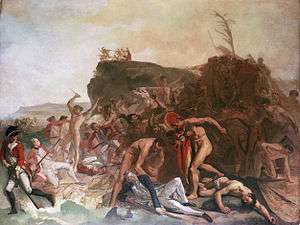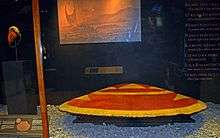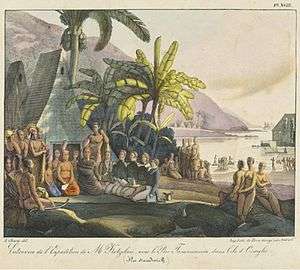Kānekapōlei
Kānekapōlei was a Native Hawaiian of high noho aliʻi (chiefly hierarchy) status and wife of Kalaniʻōpuʻu, aunt of Kamehameha I and present at the time of Captain Cook's death.
| Kānekapōlei | |
|---|---|
| Spouse | Kalaniʻōpuʻu Kamehameha I Mela[1] |
| Issue | Keōua Kūʻahuʻula Keōua Peʻeʻale Pauli Kaʻōleiokū Kahiwa Kānekapōlei[2][3] Alika Mela[1] Kahinu, w.[1] |
| House | Keawe |
| Father | Kauakahiakua |
| Mother | ʻUmiaemoku |
She called attention to the kidnapping of her husband by Cook and his sailors. A group of men from among those attracted to the beach to answer her calls for help, grabbed Cook and stabbed him to death.
Life
Born sometime in the 18th century, Kānekapōlei was a daughter of the High Chief Kauakahiakua of Maui and High Chiefess ʻUmiaemoku of Kaʻū. According to Hawaiian historian Samuel Kamakau, her father Kauakahiakua owned the sea cucumber (loli) ovens of the district of Kaupo on the island of Maui.[4] Her paternal grandparents were High Chief Lonomakahonua, the second son of King Lonohonuakini and brother of Kaʻulahea II, and Kahāpoʻohiwi.[5] Her mother ʻUmiaemoku, who was also married for a period of time to her nephew King Alapaʻinui, was an offshoot of the powerful ʻI family of Hilo district on her mother Kānekūkaʻailani's side, and a scion of the Mahi family of Kohala on her father Mahiolole's side; both families were formidable rivals to the main royal line on the island of Hawaii, the descendants of Keaweʻīkekahialiʻiokamoku.
Around 1762[6] Kānekapōlei became one of the wives of King Kalaniʻōpuʻu of Hawaii. She was not his highest ranking wife, that position was held by Kalola Pupuka-o-Honokawailani, the mother of his heir Kīwalaʻō, but was considered his favorite. With Kalaniʻōpuʻu, she had two known sons, Keōua Kūʻahuʻula and Keōua Peʻeʻale. Their first son would contend with Kamehameha I over the supremacy of the island of Hawaii until his death in 1790 at Kawaihae.[7] Nothing is known about the fate of Keōua Peʻeʻale, although historian John F. G. Stokes argued Keōua Peʻeʻale was merely another name for Pauli Kaʻōleiokū, her son with Kamehameha I.[8]
According to; "The Voyage of George Vancouver, 1791–1795: Volumes I–IV" Vancouver records the following description of Kānekapōlei; "Her Majesty is a very handsome woman, and carries in her looks & Manners a very suitable degree of dignity.[9] Vancouver writes of meeting her again in 1793. Guilt over memories of the ill fated Cook expedition had made Vancouver feel obligated to compensate with gifts as he writes; "I presented her with an assortment of valuables suitable to her former distinguished situation".[10]
Kidnapping of Kalaniʻōpuʻu

During Captain Cook's visit to Hawaii on his third voyage of exploration in 1779, he mentioned King Kalaniʻōpuʻu's favorite wife and queen Kānekapōlei. He and his men spelled her name many different ways including "Kanee-Kabareea", "Kanee-cappo-rei", "Kanee Kaberaia", "Kainee Kabareea", and "Kahna-Kubbarah".[12] Cook's second-in-command, Lieutenant James King, recounted her role in preventing the kidnapping of her husband and their two sons:
Things were in this prosperous train, the two boys being already in the pinnace, and the rest of the party having advanced near the water-side, when an elderly woman called Kanee-kabareea, the mother of the boys, and one of the king's favourite wives, came after him, and with many tears, and entreaties, besought him not to go on board.[13]
Hearing her lament, the Hawaiians gathered around the shore of Kealakekua Bay and tried to prevent their king from being taken. Cook's men had to retreat to the beach. As Cook turned his back to help launch the boats, he was struck on the head by the villagers and then stabbed to death as he fell on his face in the surf.[14][15]
Children
Keōua Kūʻahuʻula
According to Abraham Fornander, Keōua Kūʻahuʻula was to blame for the initial breakout of civil war in Hawaii after the death of his father Kalaniʻōpuʻu. He had received no lands due to his uncle Keawemauhili's claim as next in line to Kīwalaʻō. Upset from the lack of any inheritance, he gathered his warriors, retainers and kahu and prepared for full battle, including their mahiole and ʻahu ʻula. They headed towards Ke‘ei where a fight broke out among the warriors and bathers of at the beach. Keōua ends up killing a number of Kamehameha's men.[16]
Kaʻōleiokū
Kānekapōlei had a son named Pauli Kaʻōleiokū. The figure's paternity has been sourced to both Kalaniʻōpuʻu and Kamehameha I. Historians Abraham Fornander, Sheldon Dibble, and Samuel Kamakau all state Kamehameha I was Pauli's father however, sources earlier than Dibble deny this allegation and claims paternity to Kalaniʻōpuʻu. Further research has brought his paternity into question. Both Konia, his grandmother and Kānekapōlei herself, have flatly denied that Kaʻōleiokū was a son of Kamehameha I.[17][18][19][20] Kaʻōleiokū was raised by his mother. He joined his brother Keōua Kūʻahuʻula's forces in opposition to Kamehameha in 1782 after the Battle of Mokuʻōhai split the island into three warring chiefdoms.
In his book; "Pauahi: the Kamehameha legacy ", George H. Kanahele states that Bernice Pauahi Bishop's mele hānau does not actually mention Kamehameha I. He attributes the suggestion of Kaʻōleiokū being a son of Kamehameha to Joseph Mokuʻōhai Poepoe who calles Pauli; "ke keiki kamahaʻo" ("the love child"). Kanahele also states that Mary Kawena Pūkuʻi described this as part of the training of each warrior, and supposedly Kānekapōlei was chosen for this training. The author points out that the incident that created the doubt was when Keōua Kūʻahuʻula was killed at the consecration of the Puʻukoholā Heiau and Kamehameha announced that Kaʻōleiokū was the child of his beardless youth thus sparing his life. However in his note on that claim, Kanahele refers to Stokes as a counter; "For those who claim that Kamehameha did not father Kaʻōleiokū, the case is advanced by John F. B. Stokes in "Kaoleioku, Paternity and Biographical Sketch,". Her descendants by this son include Ruth Keʻelikōlani and Bernice Pauahi Bishop, founder of the Kamehameha School.[21] Elizabeth Kekaaniauokalani Kalaninuiohilaukapu Pratt claims that Kamehameha I stopped the death by calling Kaʻōleiokū his "keiki", meaning anything from his son to a nephew or even the son of a friend. Pratt states that Kamehameha's authority saved the boy and also brought him into the House of Kamehameha.[22]
Kānekapōlei was also said to be the mother of Keliʻikahekili, one of the wives of Kameʻeiamoku and mother of Hoapili, although the father is not mentioned.[4]
Kahiwa Kānekapōlei
Another figure often associated with Kānekapōlei is Kahiwa or Regina Kānekapōlei who was the mother of Kipikane, the wife of John Palmer Parker.[23] Her father was Kamehameha I however, according to Edith McKinzie, her mother was Kauhilanimaka (w).[24]
Legacy
Kanekapolei Street in Waikīkī was named after an early 1930s resident of the area named Marion Kānekapōlei Guerrero Diamond, who was named for the chiefess Kānekapōlei.[25]
Family Tree
References
- Barrère 1994, p. 458.
- Newton 1989, p. 130.
- Bergin 2004, p. 26.
- Kamakau 1992, p. 352.
- Thrum 1916, p. 50.
- Stokes 1935, pp. 33-34.
- Fornander 1880, p. 205.
- Stokes 1935, pp. 35-36.
- Vancouver 1984, p. 42.
- Smith 2010, p. 75.
- "The Death of Captain James Cook, 14 February 1779 – National Maritime Museum". National Maritime Museum. Retrieved 11 July 2012.
- Stokes 1935, pp. 33–34.
- King et al. 1784, pp. 43–44.
- Collingridge 2003, pp. 409–410.
- Kuykendall 1965, pp. 18–20.
- Fornander 1880, pp. 307-308.
- Stokes 1935, p. 18.
- Fornander 1880, pp. 333-334.
- Kamakau 1992, p. 127.
- Thrum 1916, pp. 50-51.
- Kanahele 2002, pp. 7-9.
- Pratt 1920, p. 27.
- Taylor 1950, p. 34.
- McKinzie 1986, p. 48.
- Pukui and Elbert (2004). "lookup of Kāne-kapōlei". on Place Names of Hawai'i. Ulukau, the Hawaiian Electronic Library, University of Hawaii. Retrieved December 12, 2012.
Bibliography
- Barrère, D.B. (1994). The King's Mahele: The Awardees and Their Lands. D.B. Barrère. OCLC 31886789.CS1 maint: ref=harv (link)
- Bergin, Billy (2004). Loyal to the Land: The Legendary Parker Ranch, 750-1950. University of Hawaii Press. ISBN 978-0-8248-2692-5.CS1 maint: ref=harv (link)
- Collingridge, Vanessa (February 2003). Captain Cook: The Life, Death and Legacy of History's Greatest Explorer. Ebury Press. ISBN 0-09-188898-0.CS1 maint: ref=harv (link)
- Fornander, Abraham (1880). Stokes, John F. G. (ed.). An Account of the Polynesian Race: Its Origins and Migrations, and the Ancient History of the Hawaiian People to the Times of Kamehameha I. 2. Trübner & Co.CS1 maint: ref=harv (link)
- Kamakau, Samuel (1992) [1961]. Ruling Chiefs of Hawaii (Revised ed.). Honolulu: Kamehameha Schools Press. ISBN 0-87336-014-1.CS1 maint: ref=harv (link)
- Kanahele, George S. (2002) [1986]. Pauahi: the Kamehameha legacy. Kamehameha Schools Press. ISBN 0-87336-005-2.CS1 maint: ref=harv (link)
- King, James; Clerke, Charles; Gore, John; Cook, James (1784). A Voyage to the Pacific Ocean. 3. Nicol and Cadell, London.CS1 maint: ref=harv (link)
- Kuykendall, Ralph Simpson (1965) [1938]. The Hawaiian Kingdom 1778–1854, Foundation and Transformation. 1. Honolulu: University of Hawaii Press. ISBN 0-87022-431-X.CS1 maint: ref=harv (link)
- McKinzie, Edith Kawelohea (1986). Hawaiian Genealogies: Extracted from Hawaiian Language Newspapers. University of Hawaii Press. ISBN 978-0-939154-37-1.CS1 maint: ref=harv (link)
- Newton, Eva Parker (1 January 1989). Roots & branches of Arthur Kapewaokeao Waipa Parker, Sr. & Eva Margaret Vieira. Delsby Publications. ISBN 978-0-910293-48-8.CS1 maint: ref=harv (link)
- Pratt, Elizabeth Kekaaniauokalani Kalaninuiohilaukapu (1920). Daniel Logan (ed.). History of Keoua Kalanikupuapa-i-nui: Father of Hawaii Kings, and His Descendants. Honolulu: Honolulu Star Bulletin. ISBN 978-1-104-76661-0.CS1 maint: ref=harv (link)
- Smith, Vanessa (2010). Intimate Strangers: Friendship, Exchange and Pacific Encounters. Cambridge University Press. ISBN 978-1-139-78862-5.CS1 maint: ref=harv (link)
- Stokes, John F. G (1935). "Kaoleioku, Paternity and Biographical Sketch". Hawaiian Journal of History. Hawaiian Historical Society: 15–42. hdl:10524/94.CS1 maint: ref=harv (link)
- Thrum, Thomas G. (1916). "Was There A Lost Son of Kamehameha?". Hawaiian Journal of History. Hawaiian Historical Society: 44–51. hdl:10524/96.CS1 maint: ref=harv (link)
- Taylor, Clarice B. (1950). "Kanekapolei Chiefess of Hawaii - Newspapers.com". Honolulu Star-Bulletin. Retrieved 2018-12-21.CS1 maint: ref=harv (link)
- Vancouver, George (1984). The Voyage of George Vancouver, 1791–1795: Volumes I–IV. Taylor & Francis. ISBN 978-1-317-01233-7.CS1 maint: ref=harv (link)


